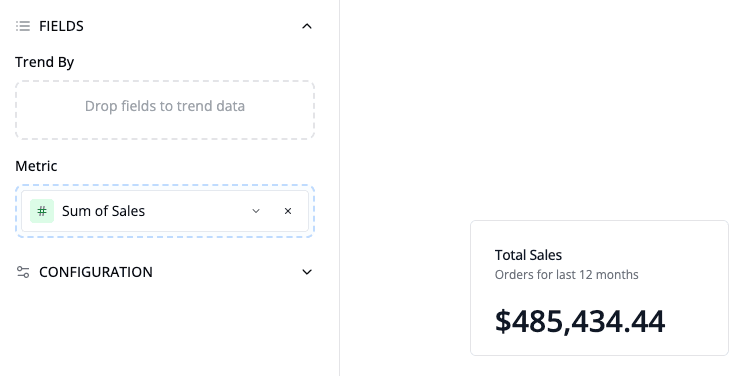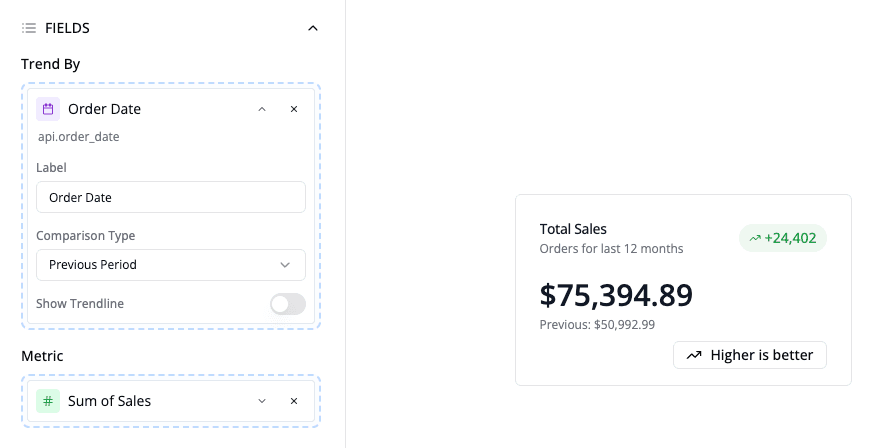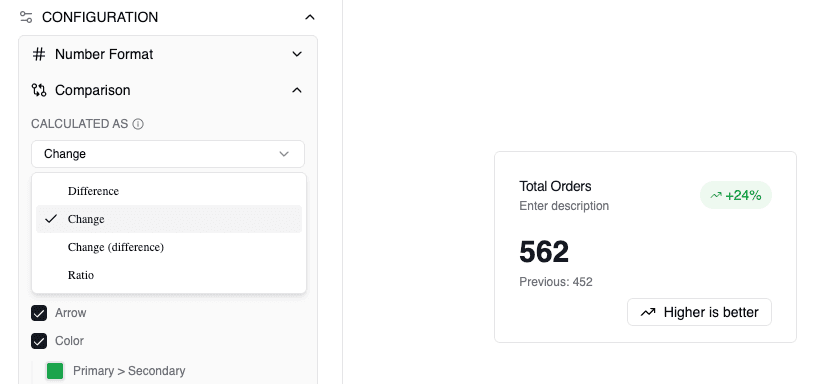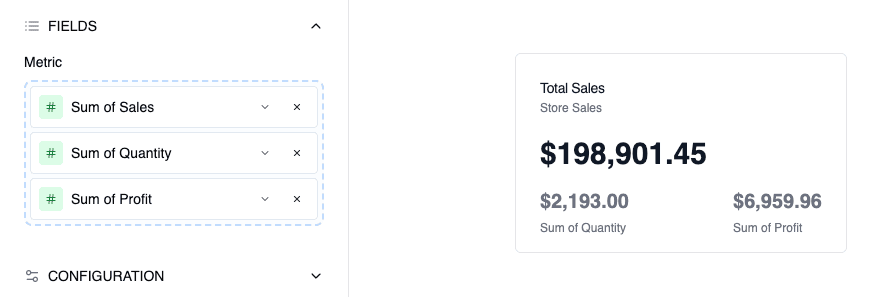KPI Cards
Learn how to create and configure KPI cards in Semaphor
Overview
KPI (Key Performance Indicator) cards display important metrics in a clear, focused format. Use them to track single values, compare performance across time periods, or display multiple related metrics together.
Single Metric KPI
Create a single metric KPI by adding one metric without any groupBy fields. This displays a large, prominent value with an optional title and description.
How to create:
- Add a metric (e.g., Sum of Sales)
- Do not add any groupBy fields
- Set a descriptive title

Period Comparison KPI
Period comparison KPIs show how a metric changes over time by comparing current and previous periods.
Example: If your Dashboard Filter is set to “July 1 – Dec 31, 2025”, the KPI shows your metric for that date range and compares it to your chosen comparison period (e.g., Jan 1 – Jun 30, 2025 for Previous Period, or July 1 – Dec 31, 2024 for Same Period Last Year).
How to create:
- Add a date field to your Dashboard Filter (e.g., Order Date, Created Date). This filter defines the current period for your comparison.
 2. Add a visual to your dashboard and select KPI as the visual type 3. Add a metric (e.g., Sum of Revenue) 4. Add the same date field (from step 1) to Trend By 5. Select a comparison type:
2. Add a visual to your dashboard and select KPI as the visual type 3. Add a metric (e.g., Sum of Revenue) 4. Add the same date field (from step 1) to Trend By 5. Select a comparison type:
- Previous Period - Compares to the immediately preceding period
- Same Period Last Year - Year-over-year comparison
- Start vs End - Compares first and last values in the period
The card displays:
- Large current value in the center
- Comparison badge in the header showing the change
- "Previous: [value]" below the main value
- Detailed tooltip on hover

Comparison Configuration
Access comparison settings in the Visual tab under the "Comparison" section.
Calculation Type
Choose how the comparison is calculated:
| Type | Formula | Example |
|---|---|---|
| Difference | Primary - Secondary | Sales increased by $5,000 |
| Change | (Primary - Secondary) / Secondary × 100% | Year-over-year sales change of 25% |
| Change (difference) | Shows both percentage and absolute | Sales grew by 25% ($5,000) |
| Ratio | Primary / Secondary × 100% | You've achieved 80% of your quota |

Format Options
Configure how comparison values are displayed:
- Currency - Display as monetary value with symbol
- Number - Plain number with optional prefix/suffix
- Percent - Display as percentage
- Scientific - Scientific notation for very large/small numbers
- Custom - Set decimal places, prefix, suffix
Indicator Settings
Customize the comparison badge:
- Arrow - Show trending arrow (up/down/right)
- Color - Customize colors for increase, decrease, and no change
- Default: Green for increase, Red for decrease, Gray for no change
- Customizable per your preference or brand colors
Labels
Conditional Labels - Display dynamic labels based on the comparison result:
- Increase - Shown when current > previous (default: "Increase")
- Decrease - Shown when current < previous (default: "Decrease")
- No Change - Shown when values are equal (default: "No change")
These labels appear in the tooltip for context.
Previous Label - Customize the text before the comparison value (default: "Previous")
- Examples: "Last Month", "Last Year", "Last Period"
Multi-Metric KPI (Up to 3 Metrics)
Display multiple related metrics in a single card when you need to show current performance alongside benchmarks or historical values.
How to create:
- Add up to 3 metrics (e.g., Current Period, Previous Period, Budget)
- Do not add any groupBy fields
Layout:
- Primary metric displays large at the top
- Secondary and tertiary metrics display side-by-side below in a 2-column grid
- Each metric shows its own label
- Card title typically describes the primary metric
Note: Comparison features are not available for multi-metric KPIs. This layout is designed for displaying multiple values, not comparing them.

Formatting
Number Formatting
- Decimal Places - Control precision (0-10 decimal places)
- Thousands Separator - Automatic based on locale
- Compact Notation - Display large numbers with K, M, B suffixes
Currency Formatting
- Currency Symbol - Select from major currencies (USD, EUR, GBP, etc.)
- Locale - Controls number formatting and symbol position
- Custom Symbol - Override default currency symbol if needed
Percentage Display
- Multiply by 100 - Automatically convert decimals (0.25 → 25%)
- Decimal Precision - Control decimal places for percentages
Color Ranges
Apply conditional coloring based on value thresholds:
- Define ranges (e.g., 0-50: Red, 50-75: Yellow, 75-100: Green)
- Values automatically colored based on their range
- Useful for status indicators and performance tracking
Best Practices
Single Metric KPIs:
- Use for the most important top-line metrics
- Keep titles clear and specific
- Add descriptions for context when needed
Period Comparison KPIs:
- Best for tracking trends over time
- Choose comparison type that matches your analysis period
- Customize "Previous" label to match your time period
Multi-Metric KPIs:
- Ideal for showing current value with context (previous, budget, target)
- Upto to 3 metrics for readability
- Use clear, concise labels for each metric
- Primary metric should be the most important value